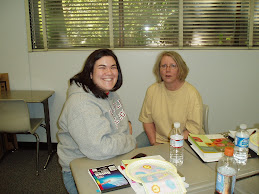Sunday, March 29, 2009
Wow! We are so close but it is so far at the same time. For me, the credential program has felt like bootcamp. Although I feel as if my brain and body can't take anymore, I feel like I am a different person going out than coming in. I think the most uncomfortable part for me is the not knowing. I have grown accustomed to schedules, and classes and syllabusses and rubrics. Now WHO KNOWS? I wonder where (if) I will be working... and starting a new job is always stressful. Will the people be nice? Will they expect me to know what I am doing? Do I know what I am doing? I am sure we will all be OK... just need chocolate. hang in there 14!
Subscribe to:
Comments (Atom)

What is Adaptive or Assistive Technology and What Does it Mean to Me?
Assistive or Adaptive Technology commonly refers to "...products, devices or equipment, whether acquired commercially, modified or customized, that are used to maintain, increase or improve the functional capabilities of individuals with disabilities..."
Assistive Technology Act of 1998
Assistive Technology Products can enable people with disabilities to accomplish daily living tasks, assist them in communication, education, work or recreation activities, in essence, help them achieve greater independence and enhance their quality of life.
Assistive Technology devices can help improve physical or mental functioning, overcome a disorder or impairment, help prevent the worsening of a condition, strengthen a physical or mental weakness, help improve a person's capacity to learn, or even replace a missing limb.
Assistive Technology Services support people with disabilities or their caregivers to help them select, acquire, or use adaptive devices. Such services include functional evaluations, training on devices, product demonstration, and equipment purchasing or leasing.
Assistive Technology Act of 1998
Assistive Technology Products can enable people with disabilities to accomplish daily living tasks, assist them in communication, education, work or recreation activities, in essence, help them achieve greater independence and enhance their quality of life.
Assistive Technology devices can help improve physical or mental functioning, overcome a disorder or impairment, help prevent the worsening of a condition, strengthen a physical or mental weakness, help improve a person's capacity to learn, or even replace a missing limb.
Assistive Technology Services support people with disabilities or their caregivers to help them select, acquire, or use adaptive devices. Such services include functional evaluations, training on devices, product demonstration, and equipment purchasing or leasing.
Assistive Technology is For Everyone
Assistive Technology (AT) is defined in the Individuals with Disabilities Education Act (IDEA) as, "...any item, piece of equipment, or product system... that is used to increase, maintain, or improve functional capabilities of individuals with disabilities." In other words, AT can be anything - from a pencil grip to a computer, a magnifying glass to a wheelchair - that helps a person perform a daily task that might otherwise be very difficult or impossible. AT accomodations can be written in to a child's Individualized Education Plan (IEP); for example, if a child has a difficult time typing on a regular keyboard, ergonomic or large-key keyboards may benefit the child and this could be written in to an IEP. AT should not be confused with Universal Design for Learning (UDL). UDL is when an entire curriculum is created and designed to differentiate instruction for every student, including students with disabilities, English Language Learners, and gifted and talented students.
Sites I Like
Welcome to my Blog
This is my blog... I am new to this world of blogology but am willing to give it a shot.





